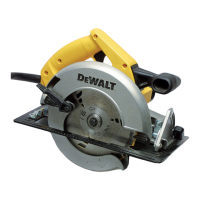Lever has been retightened (clockwise) before operating saw.
Your saw is equipped with a carbide tipped saw blade for long life and
efficient cutting.
For the most efficient cutting action using a carbide tipped saw blade,
set the depth adjustment so that about one half of a tooth projects
below the surface of the wood to be cut. The height of a whole tooth
is the distance from the tip of the tooth to the bottom of the gullet in
front of it. Study Figures 5A and 5B to determine what one half tooth
means. (5A shows one half tooth projecting below the surface and
figure 5B shows a whole tooth projecting below the surface.)
Setting the saw at the proper cutting depth keeps blade friction to a
minimum, removes sawdust from between the blade teeth, results in
cooler, faster sawing and reduces the chance of kickback.
A method of checking for the correct cutting depth is shown in Figure
6. Lay a piece of the material you plan to cut along the side of the
blade, as shown in the figure, and observe how much tooth projects
beyond the material.
NOTE: When using a non carbide tipped blade, make an exception to
the above procedure and allow a full tooth to project below the
material, as shown in Figure 5B.
BEVEL ANGLE ADJUSTMENT
DISCONNECT THE SAW FROM THE POWER SUPPLY.
The full range of the Bevel Adjustment is from 0 TO 50 DEGREES.
The quadrant is graduated in increments of 5 degrees.
On the front of the saw is a bevel angle adjustment mechanism (Figure
8) consisting of a calibrated quadrant and a lever or knob. To set the
saw for a bevel cut, loosen (counterclockwise) the quadrant lever or
knob and tilt shoe to the desired angle by aligning the pointer with the
desired angle mark. Retighten lever or knob firmly (clockwise).
NOTE: The quadrant pointer, located between the quadrant lever or
knob and the quadrant, can be adjusted after loosening its screw.
Retighten firmly after adjustment.
KERF INDICATOR
The front of the saw shoe has a kerf indicator (Figure 8) for vertical
5
English
FIG. 8
QUADRANT
KERF
INDICATOR

